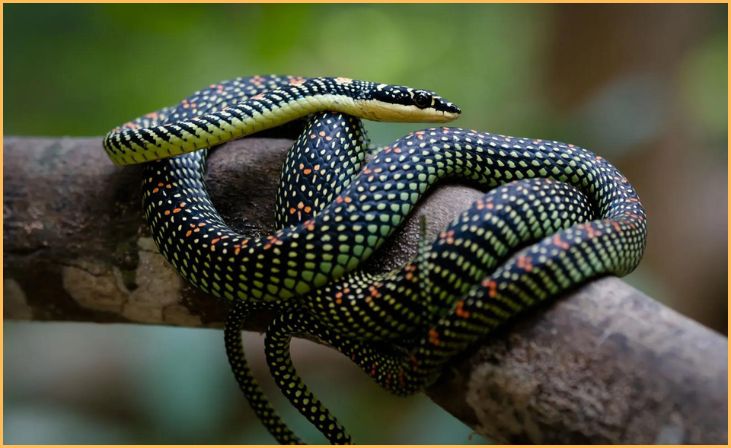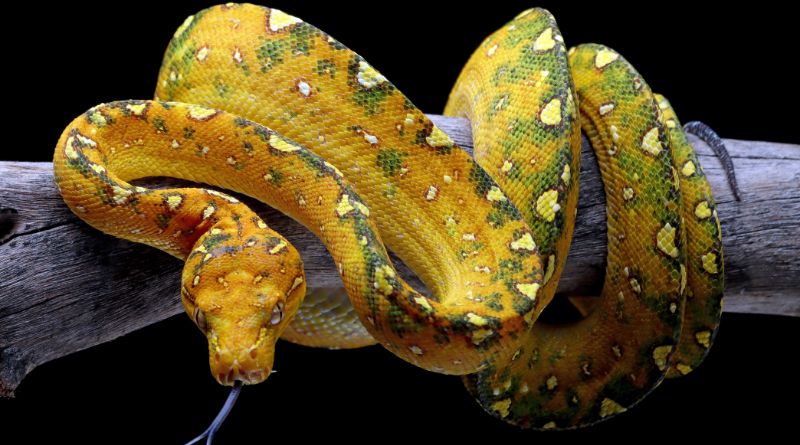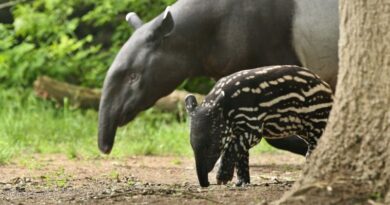Most Beautiful Snakes – Embark on a mesmerizing journey as we unveil the captivating beauty of the world’s most stunning serpents. “Discovering the World’s 10 Most Beautiful Snakes” is your passport to the vibrant and diverse realm of these elegant creatures. From the enchanting patterns of the Ball Python to the kaleidoscopic scales of the Rainbow Boa, each snake tells a unique tale of nature’s artistry. Our exploration goes beyond the aesthetic, delving into the fascinating habitats and behaviors that make these serpents extraordinary. Join us in celebrating the breathtaking world of snakes and gain a newfound appreciation for these mesmerizing reptiles.
World’s 10 Most Beautiful Snakes
Ball Python (Python regius)

The Ball Python, native to sub-Saharan Africa, stands out for its docile nature and striking appearance. Characterized by a mesmerizing mosaic of colors and intricate patterns, these snakes are a favorite among reptile enthusiasts. Their name originates from their tendency to curl into a ball when feeling threatened. With a range of morphs showcasing diverse hues, from vibrant oranges to deep blues, the Ball Python epitomizes the elegance that can be found in the snake kingdom. This species thrives in diverse environments, from savannas to forests, making it a fascinating subject for both snake aficionados and those new to the world of serpents.
Rainbow Boa (Epicrates cenchria)
Hailing from the rainforests of Central and South America, the Rainbow Boa lives up to its name with a spectacular iridescence that seems to create a living rainbow along its scales. These constrictors possess a shimmering quality due to microscopic ridges on their scales that refract light. As they move, the colors shift, creating a dazzling visual display. Beyond their radiant appearance, Rainbow Boas play a crucial role in maintaining ecological balance by controlling small mammal populations. This dual significance makes them a captivating species for both admirers of aesthetics and those intrigued by the ecological roles of these magnificent creatures.
Also Read: Biggest Fish That Command Awe and Wonder
Emerald Tree Boa (Corallus caninus)
Found in the rainforests of South America, the Emerald Tree Boa is renowned for its vibrant green coloration and arboreal lifestyle. Their emerald-green scales and distinctive white markings make them a true gem in the snake world. Preferring to coil around branches high above the forest floor, these boas are not only visually striking but also display a remarkable adaptation to their environment. This species’ unique appearance, coupled with its specialized lifestyle, underscores the intricate relationship between snakes and their ecosystems, highlighting the importance of conservation efforts to preserve these exquisite creatures and their habitats.
King Cobra (Ophiophagus hannah)
As the longest venomous snake and an apex predator in its habitat, the King Cobra commands both respect and awe. Native to the forests of Southeast Asia, this snake boasts a majestic appearance with its hooded display and distinctive coloration. Despite its intimidating reputation, the King Cobra plays a vital role in controlling rodent populations, contributing to the delicate balance of its ecosystem. Understanding the ecological significance of such visually imposing snakes adds another layer of appreciation for their existence, showcasing the intricate interplay between beauty, function, and ecological harmony in the world of serpents.
Sunbeam Snake (Xenopeltis unicolor)

The Sunbeam Snake, native to Southeast Asia, derives its name from the iridescent appearance that resembles the play of sunlight on its scales. Their smooth, glossy appearance distinguishes them from other snakes, creating a visual spectacle reminiscent of molten metal. Despite spending most of their lives underground, these secretive snakes captivate with their unique sheen and play a crucial role in controlling insect populations. Uncovering the hidden beauty of species like the Sunbeam Snake emphasizes the importance of exploring the less-known facets of the serpent world and acknowledging their vital contributions to ecosystems.
Garter Snake (Thamnophis sirtalis)
Widespread across North America, the Garter Snake challenges the stereotype of snakes as menacing creatures. Their slender bodies are adorned with vibrant stripes, creating a visually appealing contrast. Unlike some of their more exotic counterparts, Garter Snakes are non-venomous and play a crucial role in controlling pests like slugs and insects. This makes them an ideal subject for those intrigued by the intersection of aesthetics and ecological balance. The Garter Snake’s unassuming yet charming presence highlights the diverse roles that snakes play in maintaining the health of ecosystems, dispelling common myths and fostering appreciation for their unique beauty.
Coral Snake (Micrurus spp.)
Known for their bold and contrasting bands of color, Coral Snakes inhabit various regions across North and South America. Their venomous nature serves as a warning to potential predators, showcasing the intricate relationship between beauty and defense mechanisms in the snake world. Despite their venom, Coral Snakes are reclusive and pose little threat to humans when left undisturbed. Understanding the ecological role and the delicate balance these snakes maintain in their habitats adds depth to the appreciation of their vibrant patterns and contributes to the broader narrative of biodiversity conservation.
Corn Snake (Pantherophis guttatus)
Native to the southeastern United States, the Corn Snake is a prime example of the captivating beauty found in non-venomous species. With a myriad of colors and patterns resembling Indian corn, these snakes have become popular pets in the reptile-keeping community. Beyond their visual appeal, Corn Snakes are efficient hunters, preying on rodents and helping control pest populations in their natural habitats. The domestication of this species for the pet trade underscores the delicate balance between appreciating their beauty and ensuring responsible conservation practices to protect their wild counterparts and their ecosystems.
Blue Insularis (Bothrops insularis)
Endemic to Ilha da Queimada Grande, a small island off the coast of Brazil, the Blue Insularis pit viper is a mesmerizing yet elusive snake. Its striking blue coloration, a result of evolution on the isolated island, sets it apart from its mainland relatives. Despite its beauty, the Blue Insularis is a highly venomous species, underlining the coexistence of danger and allure in the realm of snakes. The rarity of this species emphasizes the fragility of certain ecosystems and the importance of conservation efforts to preserve not only the beauty of these snakes but also the biodiversity of their unique habitats.
Also Read: Signs Of Snakes Around Your House
Paradise Flying Snake (Chrysopelea paradise)

Hailing from Southeast Asia, the Paradise Flying Snake (Chrysopelea paradisi) is a testament to the extraordinary adaptations that snakes have developed. Sporting vibrant colors and an ability to glide through the air, these snakes redefine the perception of serpentine beauty. Their aerodynamic prowess and striking appearance make them a subject of fascination for researchers studying the evolution of locomotion in snakes. The Paradise Flying Snake exemplifies the diverse ways in which beauty manifests in the serpent world, inviting us to appreciate not only their aesthetics but also the marvels of adaptation that have shaped their existence.
In the intricate tapestry of the snake kingdom, each species weaves a unique story of adaptation, beauty, and ecological significance. From the enchanting patterns of the Ball Python to the majestic presence of the King Cobra, these snakes captivate with their diverse colors and behaviors. Exploring the world of serpents unveils not only the aesthetic appeal of these creatures but also the vital roles they play in maintaining the balance of ecosystems. Whether coiled in a ball or gliding through the air, each snake is a masterpiece of nature, inviting us to appreciate the serpentine splendor that graces our planet.
Conclusion
As our serpent sojourn concludes, we’ve unraveled the kaleidoscope of beauty hidden within the slithering world. “Serpentine Splendor” has showcased the awe-inspiring diversity of nature’s canvas through the 10 most beautiful snakes. From the rainforests to arid deserts, these reptiles embody the poetry of evolution. As we marvel at their enchanting colors and patterns, let us cherish the delicate balance of our ecosystems and the role each snake plays. Our journey into the world of these graceful creatures has not only enriched our understanding but also kindled a deeper admiration for the wonders that grace our planet.
FAQs
A snake’s beauty is often attributed to its unique coloration, intricate patterns, and distinctive markings, which serve various purposes such as camouflage, warning signals, or species identification.
No, not all beautiful snakes are venomous. Many visually striking snakes, like the Garter Snake and Corn Snake, are non-venomous and pose no threat to humans.







